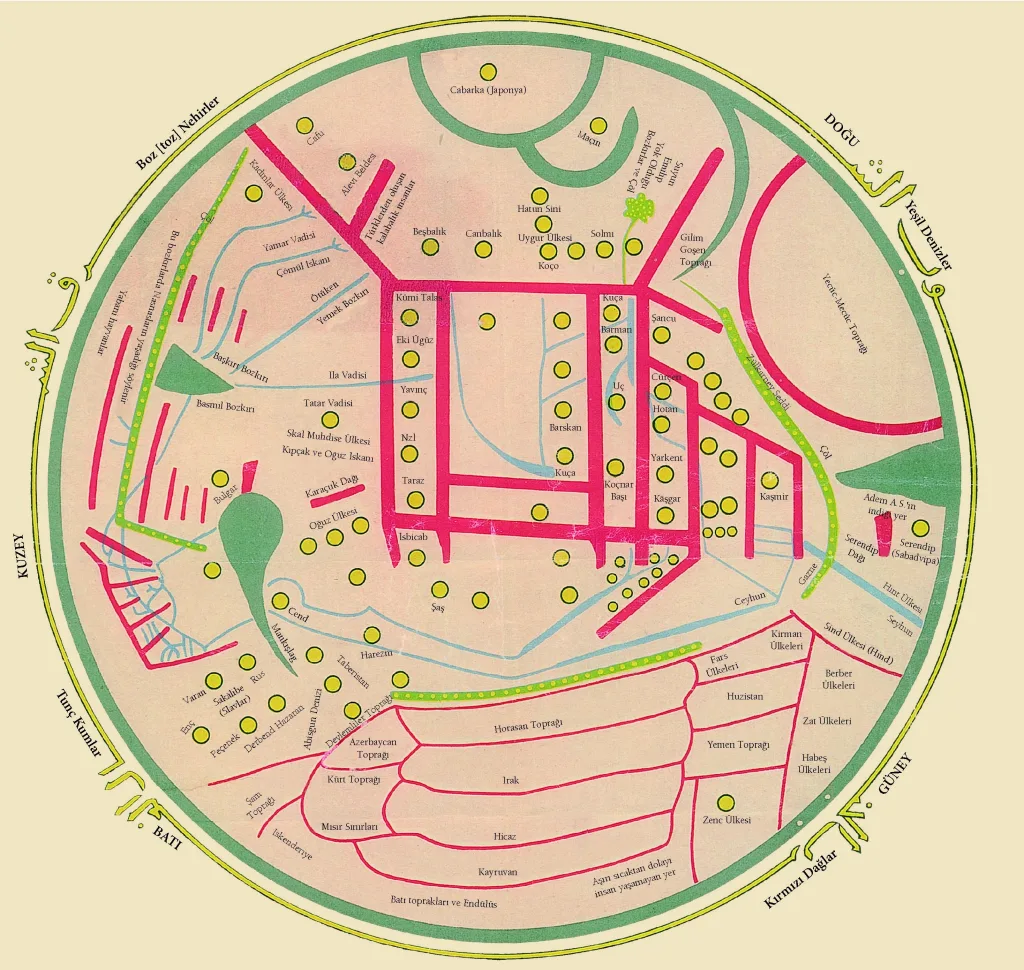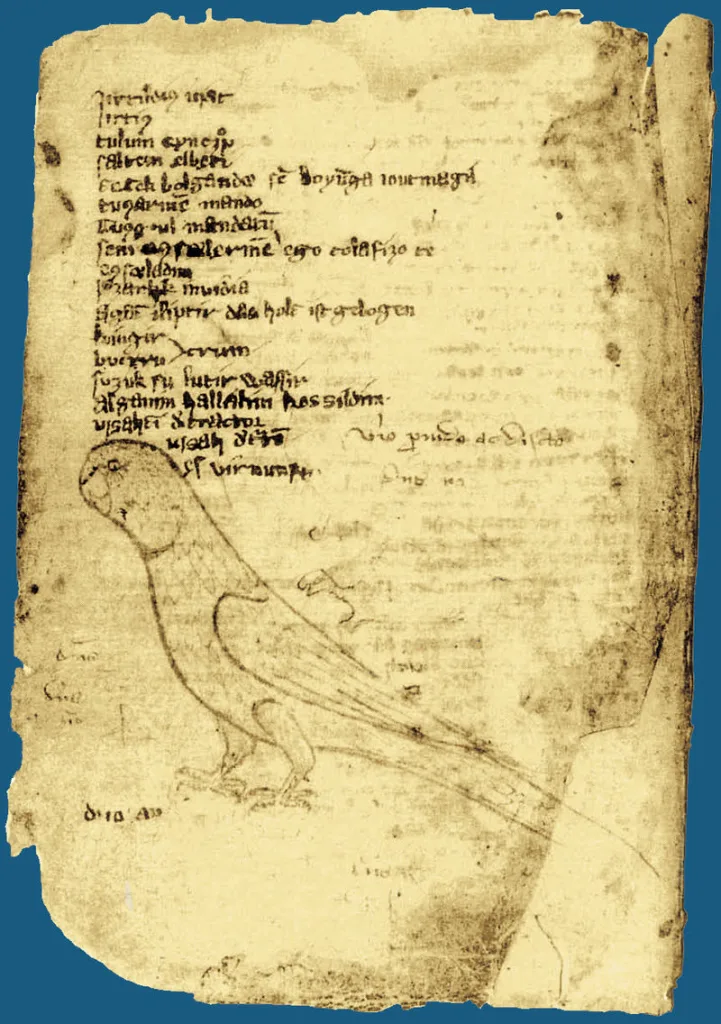The Divânu Lügati’t-Türk is one of the most important works in the history of the Turkish language. Compiled by Kaşgarlı Mahmud between 1072 and 1074, it is far more than a dictionary; it offers a detailed cultural, literary, and geographical portrait of the 11th-century Turkic world. Written in Arabic to introduce Turkic languages to the Arab world, it contains over 9,000 words, proverbs, poems, and ethnographic notes, making it an indispensable source for scholars of linguistics, history, and folklore.
Complementing this, the Codex Cumanicus, compiled in the late 13th or early 14th century, provides a key record of the Cuman–Kipchak dialect. Unlike Kaşgarlı Mahmud’s comprehensive cultural showcase, the Codex Cumanicus was primarily a practical tool for trade and missionary work across the Black Sea and Danube regions. Written in Latin script and often trilingual (Latin–Persian–Cuman), it preserves vocabulary, riddles, religious texts, and proverbs, offering unique insights into the interaction of Turkic languages with European and Persian cultures.
Together, these two works illuminate the richness and diversity of medieval Turkic languages, showing how different Turkic-speaking communities were documented and understood across regions and centuries.
Who Was Kaşgarlı Mahmud?

Kaşgarlı Mahmud, whose full name was Mahmud bin Hüseyin bin Muhammed, was born in the city of Kashgar during the Karakhanid period (around 1008 CE). He received a strong madrasa education, mastering Arabic, Persian, and multiple Turkic dialects. He spent years traveling across Central Asia, visiting Turkic tribes, collecting words, idioms, proverbs, epic fragments, and documenting their customs, traditions, and way of life.
UNESCO declared 2024 as the Year of Kaşgarlı Mahmud to mark the 1,000th anniversary of the work’s creation. Today, it remains an indispensable source for linguists, historians, and anyone interested in the heritage of the Turkic world.
Purpose of the Work
Kaşgarlı Mahmud presented his dictionary to the Abbasid caliph al-Muqtadī bi-Amr Allāh in Baghdad. His goals were to:
- Teach the Turkic language to Arabs.
- Demonstrate the richness and systematic nature of Turkic.
- Introduce the culture, values, and worldview of the Turkic peoples.
While the Divânu Lügati’t-Türk was designed for scholarly and cultural purposes, the Codex Cumanicus served practical and missionary needs. It facilitated communication for trade and religious instruction among Cumans, Europeans, and Persians, reflecting a different but complementary dimension of Turkic language documentation.
The First Known Map of the Turkic World

The Divânu Lügati’t-Türk includes the first known map of the Turkic world, showing:
- Locations of major Turkic tribes (Oghuz, Kipchak, Karluk, Yagma, Chigil)
- Rivers, lakes, and mountain ranges
- Key political and cultural centers, such as Balasagun
The Codex Cumanicus, while lacking a map, provides rich linguistic context for the Black Sea and Danube regions, helping scholars reconstruct medieval Kipchak settlements and trade routes. Together, the two works complement each other geographically and linguistically.
Contents

The Divânu Lügati’t-Türk includes:
- Over 9,000 Turkic words with Arabic equivalents
- Proverbs and idioms
- Poems and epic fragments
- Grammatical notes and dialectal differences
- Cultural explanations about customs, games, ceremonies
- Ethnographic observations on clothing, weaponry, and daily life
Similarly, the Codex Cumanicus contains:
- Vocabulary for merchants and missionaries
- Riddles and short literary forms
- Religious texts and prayers
- Basic grammar guidance for Latin speakers learning Kipchak

10 Interesting Words from the Divânu Lügati’t-Türk
- Yamçı – A raincoat, waterproof garment
- Çögün – Ceremony, celebration
- Yaba – A farming tool, pitchfork
- Tokuz – The number nine; also the name of a tribe
- Kutad – Order and justice of the state
- Yıgaç – Tree
- Köŋül – Heart, emotions, spirit
- Üskük – Headgear, cap
- Suv – Water
- Bilig – Knowledge, wisdom
Selected Proverbs from the Divânu Lügati’t-Türk
These proverbs not only illustrate linguistic richness but also reveal the values, worldview, and everyday experiences of Turkic societies in the 11th century.
- “Köngül köngülden su içer.”
Translation: The heart drinks from another heart; sincerity is met with sincerity. - “At igidlig erdem teg.”
Translation: A horse is to a brave man what honor is to virtue. - “Tegirmende un eksük bolmas.”
Translation: There is never a lack of flour in the mill; in the right place, the right thing is always found. - “Er başın alp bolur.”
Translation: A hero is made by preserving his honor. - “Süçig söz süçi bolur.”
Translation: Sweet words bring sweet responses. - “Közi tok er arıg bolur.”
Translation: One whose eyes are content has a pure heart. - “Beg er atıng süsi.”
Translation: For a ruler, the love of the people is the finest adornment. - “Kök üze bulut kelür, kişi başına keder kelür.”
Translation: Clouds come to the sky, sorrow comes to man; life has its ups and downs. - “Ot taşka tegse söner, er öfkeye tegse küser.”
Translation: Fire striking stone dies, a man striking anger withdraws; harshness cools warmth. - “Yıgaç kökermese budak vermez.”
Translation: A tree cannot branch before it greens; growth requires a strong foundation.
The Codex Cumanicus: A Medieval Companion to the Divânu Lügati’t-Türk
While the Divânu Lügati’t-Türk was compiled in the 11th century to introduce Turkic to the Arab-Islamic world, another important manuscript emerged in the late 13th or early 14th century; the Codex Cumanicus. This work focuses on the Cuman–Kipchak language, spoken by nomadic tribes in the Eurasian steppe, and reflects a completely different cultural and historical context.
The Codex Cumanicus is thought to have been compiled in the Crimea by Franciscan missionaries and Venetian merchants. At the time, the Cumans (Kipchaks) were a dominant force from the Black Sea to the Danube, influencing trade, diplomacy, and even the Mongol Empire’s governance.
It is divided into two main sections:
- Italian–Persian–Cuman Vocabulary – A practical phrasebook for merchants to facilitate trade.
- Latin–Cuman Section – Created by missionaries for religious teaching, containing prayers, Bible translations, and grammatical explanations.
Unlike the Arabic-script Divânu Lügati’t-Türk, the Codex Cumanicus is written in Latin script, offering invaluable clues about the pronunciation of medieval Kipchak.
- Provides one of the earliest records of the Kipchak branch of Turkic languages.
- Demonstrates heavy influence from Persian, Arabic, and Latin, showing a multicultural environment.
- Contains riddles, proverbs, and short literary pieces from Cuman oral tradition.
Why Both Matter
Together, these two works provide a fuller understanding of medieval Turkic languages:
- Divânu Lügati’t-Türk: An insider’s scholarly portrayal of Turkic culture and language for the Islamic world.
- Codex Cumanicus: An outsider’s practical tool for communication and conversion in the Latin-Christian sphere.
Both remain cornerstones of Turkic historical linguistics and essential cultural heritage treasures.
Divânu Lügati’t-Türk vs. Codex Cumanicus
| Feature | Divânu Lügati’t-Türk | Codex Cumanicus |
|---|---|---|
| Date | 1072–1074 | c. 1294–1303 |
| Author | Kaşgarlı Mahmud | Anonymous (multiple compilers) |
| Purpose | Linguistic, cultural showcase for Arabs | Trade and Christian missionary work |
| Languages | Arabic with Turkic examples | Latin script, trilingual (Latin–Persian–Cuman) |
| Scope | Pan-Turkic | Primarily Kipchak-Cuman |
| Cultural Content | Ethnography, poetry, proverbs | Riddles, religious texts, basic proverbs |

